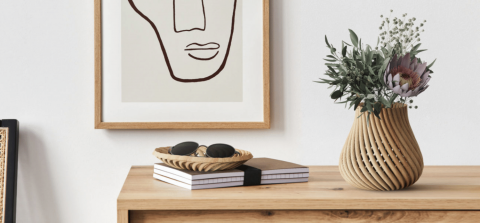
A new process allows manufacturers to 3D-print a sustainable wood composite to create wood furniture and building elements, in novel forms
Swiss Designer Yves Béhar is known for his work with recycled and sustainable materials. His newest design is a homeware collection for additive manufacturing company, Forust. Called Vine, the range is produced by 3D-printing a wood composite into complex shapes.
To create the composite, sawdust is mixed with a natural tree-sap binder. The composite is then printed in layers, to replicate the natural look of wood grain and to create complex shapes. Forust claims the finished product is also as durable and strong as timber. The Vine range of bowls, baskets and trays is beautiful and practical, but it is also more sustainable than timber, because it is made from wood waste.
Subtractive processes, such as lumber milling, leave behind a great deal of sawdust. Some of this is used to make products like particle board, but a great deal is sent to landfill or burned. Béhar claims that almost 50 per cent of timber is wasted in this way. By diverting some of this sawdust to create the printable composite, Forust is saving materials that would otherwise go to waste.
The 3D-printed wood can not only reproduce a wide variety of wood grains, but can also incorporate stains such as oak, ash and walnut. Forust CEO Andrew Jeffery explains that the process, “leverages high-speed binder jetting to selectively deposit binder or ink onto each layer of sawdust at a rate of over 670 million drops per second and a resolution of 1600 dots per inch.”
By now, we have seen what the future of 3D-printing has to offer. From an entire printed community to EV engine parts, 3D-technology is growing by leaps and bounds. In the future, we may be able to print almost anything, from food to medicine and perhaps even clothing.